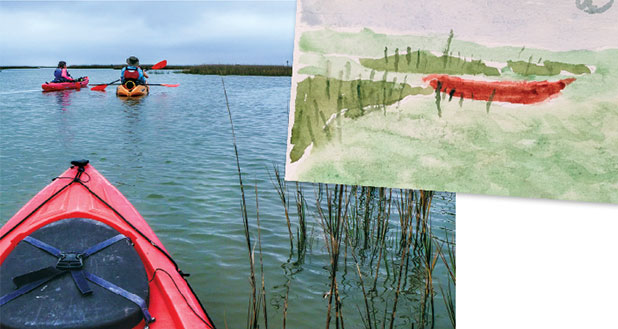
A pleasant breeze rocked my kayak and rustled pale green and brown marsh grasses around me. Overhead, a few wispy clouds drifted across a blue sky.
A heron squawked nearby, and the faint growl of a motorboat carried from the distance. Nary a peep came from the group of paddlers scattered around me, each of us clutching paintbrushes and thick watercolor paper fastened to cardboard with masking tape.
Welcome to Artist Boat Adventures in Galveston, an unexpected pairing of art-making and kayaking. My sister Janet Wray, who has created many a work of art but never kayaked before, and myself, an avid kayaker but certainly no artist, represented a definite test of Artist Boat’s claim of “no experience necessary.” The nonprofit organization integrates art and science to promote awareness and preservation of coastal habitats, including Galveston Bay. It offers guided “eco-art” tours at nearly a dozen locations from the lower Trinity River to Drum Bay.
For this program, we gathered with a half-dozen other participants at a kiosk on Oak Bayou, an inlet on the bay side of Galveston Island State Park, where a row of brightly colored kayaks and our Artist Boat guide, biologist Kari Howard, await-ed. After a quick lesson in paddling technique, we slathered on sunscreen, snapped on life jackets, loaded up with water and snacks, and launched our boats off the end of a boardwalk.
For more than an hour, we wandered the shallow bay, circumnavigating islands of marsh grass that sheltered white egrets, great blue herons, pelicans, and roseate spoonbills. Kari pointed out the various birds and gave us updates about restoration efforts in the bay. We paddled over a recently planted seagrass bed, the primary food for green sea turtles, and past restored plats of marsh grasses, which help create wetlands. Kari filled us in on the important functions of the wetlands, including reducing flooding, holding sediment together to maintain land mass for the island, filtering pollutants from the water, and providing a safe haven for the young of such commercially important marine species as shrimp, blue crab, and many varieties of fish.
Then, with all of our boats pulled up against a small island, we unloaded the art supplies from boxes strapped to each kayak. These included paper, paintbrushes, a set of watercolors, and a plastic tray with little wells for mixing. Kari talked us through the process, suggesting we first cover our paper with a background color and then place a horizon line two-thirds of the way up the page. She pointed out how subtly the color changed from water to shore to sky, and showed us how to mix those shades from our paints.
Once back on shore, we shared our finished creations. In less than an hour, working on moving boats, the group had produced surprisingly beautiful images. I’d heard that being in nature makes people more creative, and here was tangible evidence right in front of me.
“I haven’t painted with watercolors since high school, and it’s probably the most difficult medium I’ve ever worked with, but I found Kari’s tips helpful,” Janet told me. “At first, I was somewhat uninspired by the limited color in the terrain, but that forced me to stretch creatively.”
Kari hopes that Artist Boat will serve to educate more people about the less-famous side of the island. “Galveston Island’s bay side is often overlooked, but it’s an ecological jewel, with more than 600 species of birds,” she said. “The Galveston Bay watershed begins in the Dallas-Fort Worth area with the Trinity River and covers 33,000 square miles. More than half the population of Texas lives within this watershed.”
She referenced a famous 1968 quote by Baba Dioum, a former agriculture minister in Senegal who served on the executive committee of the International Union for the Conservation of Nature: “In the end, we will conserve only what we love, we will love only what we understand, and we will understand only what we are taught.”
“The work we’re doing is important because it ties back to conservation—an issue that’s certainly timely in light of the recent oil spill here in the bay,” said Kari. “If enough people care about these environments, they will be protected and conserved. A big component of Artist Boat is educating the public about these coastal margins and making the connection between human actions and wildlife. We want ordinary people to rally for their own small parts on this big planet.”








